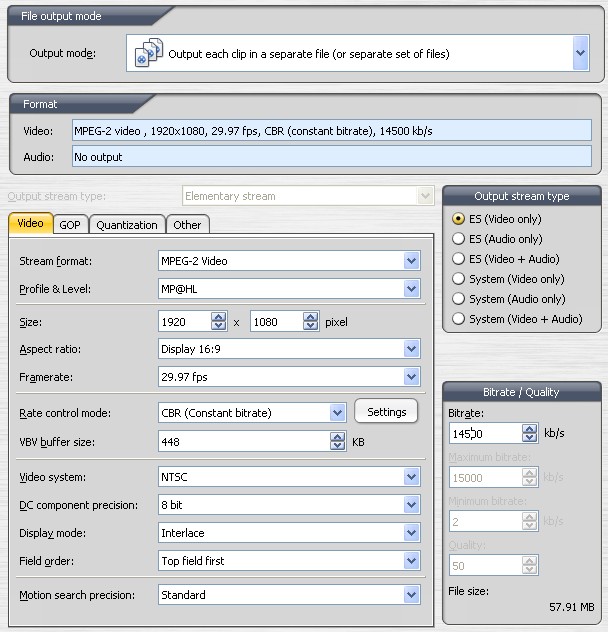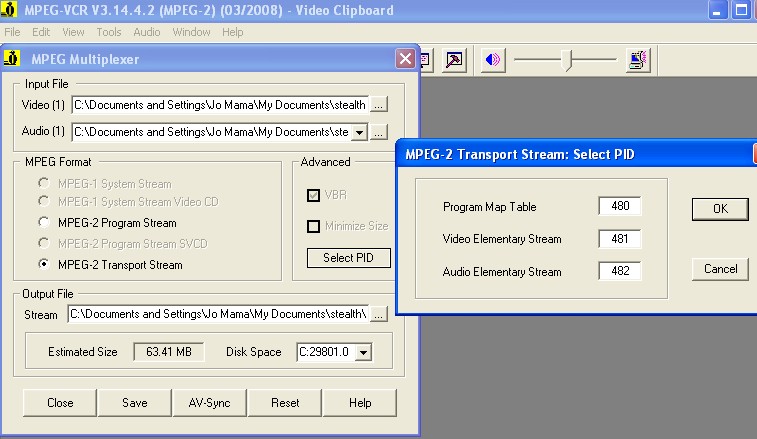Hi,
I'm new to the Mpeg2 transport stream delivery method and Multiplexing so I have a bunch of questions. I saw a post from soopafresh from jan 2008 that got me most of the way but still need some help. Here is what we are doing; We are delivering 5 to 8 minute hd segments to a national cable company for broadcast and distribution via their specs below. We cut on a PC Avid MC 2.5.3- projects are 1080i 59.97 then export a quick time reference to TMPGEnc express ver 4.5.2.255. and then multiplex the files in MPEG-VCR. The specs in Bold are the ones that I'm not sure if I have correct in the encoding of the mpeg2.
TMPEG specs below and questions.
TMPEG specs
Elementary Stream, MP@HL
MPEG-2 video , 1920x1080, 29.97 fps, CBR (constant bitrate), 10000 kb/s
Dolby Digital, 48000 Hz, Stereo, 192 kbps
GOP- closed GOP IBBPBBPBBPBBPBBP
VBV Buffer size 224
Questions
1. I'm not sure if the GOP is correct
2. What would be a good bitrate for broadcast?
We are currently testing mpeg-vcr to mux and create the MPEG-2 Transport Stream and set up the required PID. But once I run the .m2v/ac3 files created in TMPGEnc through the MPEG multiplexer it just give me a .mpg file not a .m2t is that correct??
Do I still have to run that file through the MPEG systems Stream converter in MPEG-VCR to get a proper transport stream?
Is there any other better programs for the multiplexing???
High Definition VOD Encoding Specification (VOD Ready)
MPEG2 Transport Stream:
Continuous single program transport stream (SPTS)
Constant bitrate, 188 byte packets
Transport rate = 15.0 Mbps. Dolby AC3 Audio encoding
PMT PID=0x1e0 (480)
Video PID=0x1e1 (481)
Primary Audio PID=0x1e2 (482)
Secondary Audio PID=0x1e3 (483)
Program Number=0x001 (1)
Standard MPEG2 PSI and PCR rates
Video Encoding
MPEG-2, Main Profile, High Level
4:2:0 Chroma Sub-sampling
Frame rate = 29.97 Frames per second for 1080i or 59.94 Frames per second for
720p (*720p is still pending approval from the MSOs)
Possible resolutions include 1920 x 1080i and 1280 x 720p (*720p is still pending
approval from the MSOs)
3:2 film mode detection enabled
Nominal GOP range = 12 to 22 but depends on Server Vendor requirement
3 seconds of black at start of clip and 3 second of black at the end of clip
Captions EIA708 / SCTE-21 if available
Baseband Video Standards Not all may apply:
SMPTE 240M Signal Parameters for 1125-Line High Definition Video
SMPTE 260M Digital representation for 1125/60 High Definition Systems
SMPTE 274M 1920 x 1080 scanning and interface
SMPTE 292M Bit-Serial Digital Interface for High Definition systems
SMPTE 296M 1280 x 720 Scanning, Analog and Digital representation
Audio Encoding
Adhere to Dolby Digital AC3 Encoding specification
48 kHz sampling
Compression profile = Film Std or Light
Dialog Normalization (Dialnorm) should match the level of average spoken
dialogue (speech) within the encoded audio program. This method is consistent
with industry standards for Dolby AC3 Encoding
Audio Bitrate
Primary = 192 kbps for Stereo or 384 kbps for Dolby Digital 5.1
Secondary (if available) = 128 kbps
Baseband Audio Standards Not all may apply
AES/EBU Digital Audio standard
SMPTE 299M 24-bit Digital audio format for HDTV Bit-Serial Interface
Reference Level: 20 or 18 dBFS, Peaks not to exceed 0 dBFS.
48 kHz sampling
thanks
Aaron
+ Reply to Thread
Results 1 to 23 of 23
-
-
I don't have all the answers, but 10000 kb/s is low for 1920x1080 mpeg2. I recall most of the HD stuff I've captured over the air is at 14000k. That's still kind of low for fast moving scenes. So up it to the 15000k that they're requesting.
But once I run the .m2v/ac3 files created in TMPGEnc through the MPEG multiplexer it just give me a .mpg file not a .m2t is that correct??
The extension might be .MPG, but if you chose transport stream file with PIDs in MpegVCR during the muxing, then it's created an M2T file with a .mpg extension. No need to run it through the streams converter. You should be able to rename the file extension to M2T or TS
Since they want 1080i, I'm guessing they want top field first (TFF) interlaced MPEG2 transport streams. Are you encoding in TMPGencXpress for the output to be interlaced?
Your VBV Buffer size at 224 might be low. Maybe kick it up to 448.
Here are the specs of an Over the Air Transport stream that's been captured at 1080i. The stuff I'm pointing to in red is important.

As far as the AC3 audio settings go, you can use an app from Wisodev to create high quality audio with the required settings. http://www.wav2ac3.com
See images below


-
thanks so much Soopafresh,
I was hoping you would reply because it seems you know your stuff.
I downloaded the Wav to AC3 and will give that a try. Should I keep Dialog normalization on 31(defaught)??? I'll do some reasearch on them
but since I have music, vo and interviews in each segment which is better film light or film standard. So I will eport the audio as a wave from AVID, import into wave to ac3 instead of haveing tmpgenc convert the audio. Then have mpeg-vcr mux the mp2 file from tmpgenc and the new ac3 file.
As far as the file extention to TS thats easy enough.
How will I know if the Chroma sub -sampling is 4:2:0?? Idon't see a setting in tmpgnc?
yes it is Interlaced top field first.
I also use the Motion search precision on Highest(with error correction) it takes a lot longer but not sure if it really helps any thoughts???
any help on the GOP??? should it be closed???
In the "specs of an Over the Air Transport stream" you sent what does "tff" stand for???
How are you getting those great screen captures?
Doing a few more test and will send the distributor a short file to see what they say.
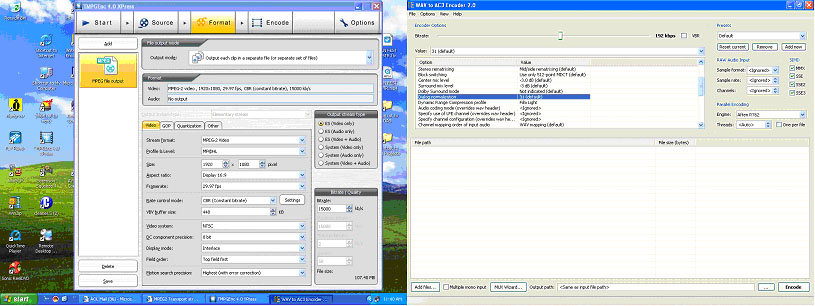
-
I downloaded the Wav to AC3 and will give that a try. Should I keep Dialog normalization on 31(defaught)???
It doesn't matter with 2 channel stereo audio - it's designed for 5.1 Dolby
"The Dialnorm value expresses the level of dialogue as how much lower it is then the peak (0 dB). So a value of "-31" indicates a point 31 dB below the peak and, incidentally, is the value at which no volume adjustment is performed by your consumer decoder. A Dialnorm value of -27 would indicate to your decoder that the dialogue is at a point 27dB below the peak, or 4dB higher than a program with a Dialnorm value of -31. The -27 setting "fits" movie soundtracks perfectly in that it yields a very natural level for talking and is likely the most common for movies. For decades this has been the standard level for dialogue in motion picture soundtracks"
http://www.hometheaterhifi.com/volume_7_2/feature-article-dialog-normalization-6-2000.html
I also use the Motion search precision on Highest(with error correction) it takes a lot longer but not sure if it really helps any thoughts???
Highest precision is overkill
How will I know if the Chroma sub -sampling is 4:2:0?? Idon't see a setting in tmpgnc?
4:2:0 is the only choice you get with MPEG2, so it's assumed. I shouldn't have pointed to it.
any help on the GOP??? should it be closed???
Doesn't matter, but closed is fine
In the "specs of an Over the Air Transport stream" you sent what does "tff" stand for???
Top Field First http://www.afterdawn.com/glossary/terms/top_field_first.cfm
TFF is standard with HD transport streams
How are you getting those great screen captures?
A favorite utility of mine, Fscapture
http://www.portablefreeware.com/?q=fscapture&m=Search -
Great thanks again, I'm uploading a one minute clip to my ftp site now to send to Comcast for tests.
I changed the file extension to .ts and played it back in VLC media player. Quality looked good and audio was in sync but it was very choppy. Not sure if that was due to the interlacing or if it was something else.
I'll check out Fscature -
Originally Posted by stealthProd
If it stays choppy, try increasing the VBV setting, up to 896 . But it shouldn't matter to comcast, as they'll be using a hardware solution to broadcast the stuff. -
thanks, I just sent them the test link. If you are interested take a look, the file is called "CC_TES.ts" it's only a minute around 114mg
http://www.stealthprod.com/CC/
Fscature is awsome -
Downloaded it. Sorry to tell you, but there's something wrong.
Run it through System Streams Converter in MpegVCR . It made the playback smoother on my system.
The best way to fix it is with VideoRedo .

Change the settings to the same as this

Open the file in Quickstream Fix

Make sure to save as .TS

-
wow hmmm I must be doing something wrong. I tried the suggested fix and it looks better but still choppy. uploading the file now to the same link file name"CC_TEST_videoRedo.ts"
Now that I have the FSCapture I'll go through and grab screens of the whole process and maybe we can see the problem.
here is the last screen on videoRedo
Thanks so much
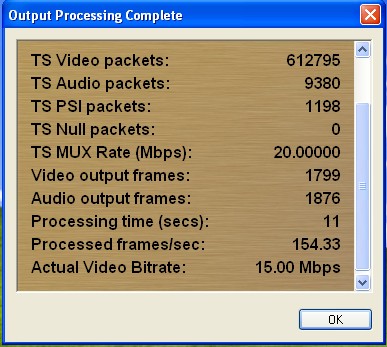
-
Just a couple points of clarification:
#1
MP@HL defines the 4:2:0 colorspace/color subsampling.
There are other colorspaces available for MPEG in general (e.g. 4:2:2), but not for MP@HL.
#2
Your required Transport rate says: 15 Mbps. (Should = TS Mux rate)
So your video should take up all of that except for the 192kbps AC3 audio and a little bit of headroom--say 14.5Mbps.
#3
What is your source? If it isn't 24p filmlike material, you won't need 3:2 pulldown. That's only for IF your material was 24p sourced.
#4
GOP length of 15 for NTSC works out very nicely (1/2 sec per I frame).
Plus, it's in the middle of the acceptable range. The GOP pattern you showed --IS-- a 15frame length, so that's fine, too.
#5
Open GOPs are more efficient compression-wise, but a little tricker for FF/RW or editing. You decide (since they didn't specify).
#6
DialNorm MUST be set on all AC3 files. Contrary to Soopafresh's statement, this IS important for CONSISTENT program-to-program AVERAGE levels (remember this is going out to consumers' homes). Not Peak levels. If you're not sure how this all works out, you can at least get by for now just by leaving it alone (set at -31dbm, although -27dbm is also often used as a default), but to DO IT RIGHT you would check your program level with peak and RMS level meters referenced with various other programs all near the same expected level, and a calibrated playback system with an SPL meter. This should BEST be done during passages where the is predominantly just speech.
#7
VBV shouldn't be changed from the suggested numbers without a VERY GOOD REASON. The whole point of VBV is to have a preset buffer size and this is VERY dependent upon the hardware and application. IOW, there is a single standard VBV for VCDs, another one for DVDs, and there should also be ones for BDs and HDDVDs, and likely (AFAIK) should be just one for DVB and OTA/VOD stuff. Find out what this should be and keep it there. Soopafresh mentioned 448, but the screencap shows 488! BTW, this is EVEN MORE IMPORTANT for hardware setups (like broadcasting and settops).
All the other stuff, I would quite agree with Soopafresh about.
Scott -
thanks Scott for the added info and the answer below
1. great
2. I changed the bitrate to 14500kb/s
3. 1080i 59.94 most of the material is from Ikegami field packs or HDCAM
4/5. I guess I'll keep it closed unless they want it changes
6. alright then I'll work on that once I get everything else figured out and working with all the whole 7 minute segments. Typically we have music under the whole segment.
7. I'll find out from Comcast what they recomend
Ok I tried again and here is the grabs from this time around.
video is uplaoding to my ftp "COM_30SEC_V_redo.ts"
I made is shorter around 30 seconds in length but it still seems very choppy. I thought it might be the frame rate when I bring it into tmpge so I tried it at 59.94 & 29.97 but still the same choppy end result???
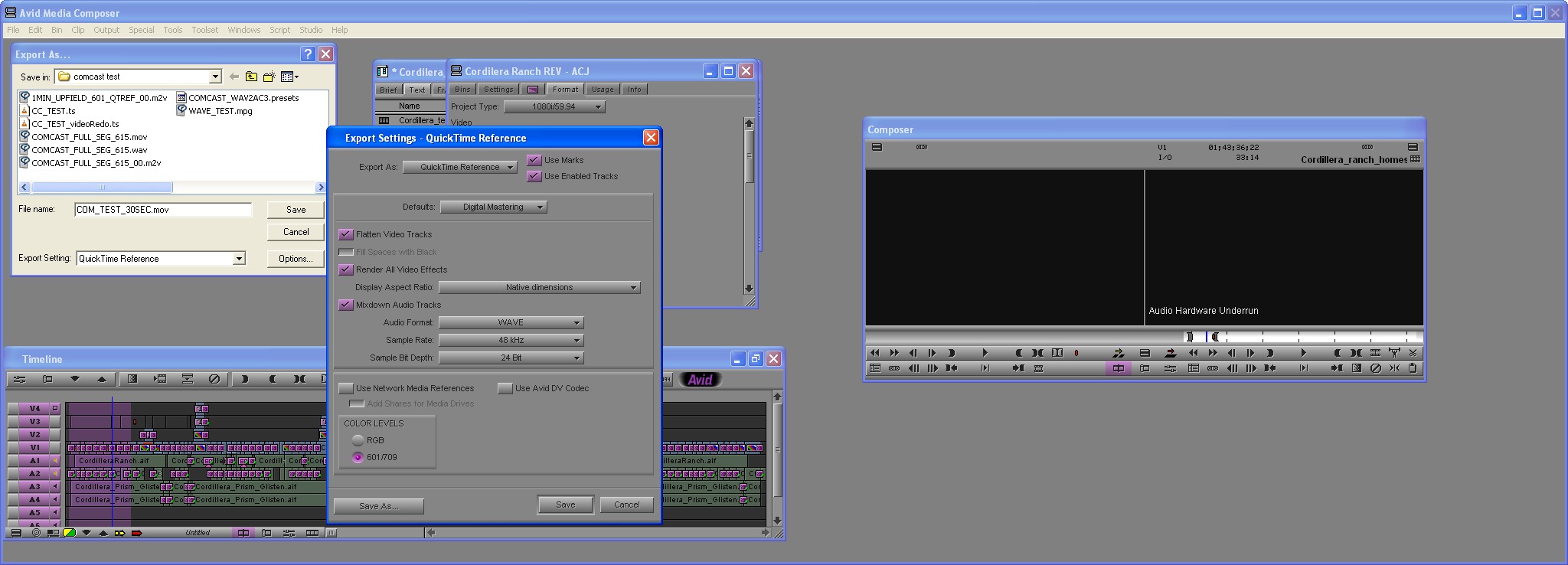
-
Your 30sec clip seems to play fine on my PC.
Try changing this value to 1194

-
Hmm still seems choppy on my end. What program are you using to play the file? I'll take the file over to my other Avid and see how it plays over there. I'm not sure if it's because I'm monitoring it on a progressive computer monitor or if it is possibly my quick time reference out of the Avid. Im trying a few more tests with different exports from Avid. The last test with the VBV up to 1194 is uploaded tp my ftp.
com_test_30SEC_1194_redo.ts
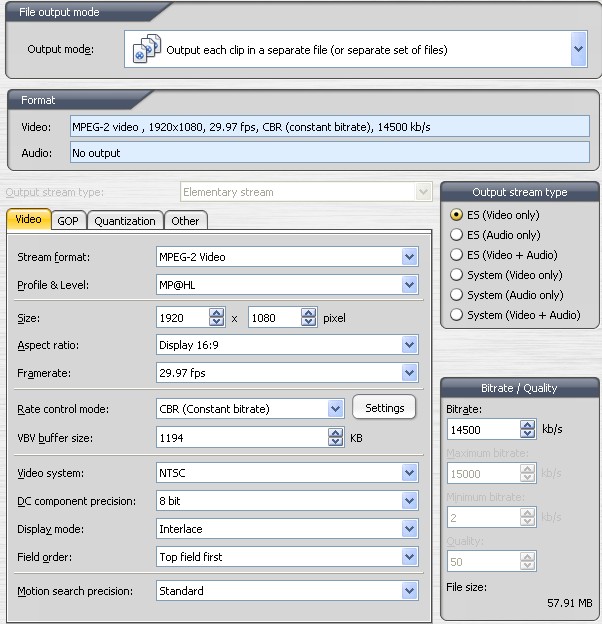
-
Well is seems to play much smoother on my other system but not perfect. A few more test, test, test, test.
-
a couple thoughts.
if it were me, and i were doing this with tmpgenc, i wouldn't use anything but the motion search precision setting of "highest (with error correction)". it might get rid of some of the choppiness. it is only a $29 encoder and you are going to be broadcasting this up against video encoded with $50,000 hardware units.
i may be wrong but seem to recall broadcast usually uses 1920x1088 encoding with the first 8 lines discarded at transmission.
i'd put the vbv buffer back at 448
i'd try to find another encoder that can do gops of 15 not 16 for 29.97fps.
if you want to upload a sample of the source, some folks might work on it to help out. -
Yes I forget how long it's been since I built this box but she might be time to upgrade. The other Avid is an hP xw8200.
Thanks Minidv2dvd
I did another test with Highest with error correction and vbv 448 as you suggested and compared it to the last and seem to be the same good but in the pans and pulls it's a little choppy. I've emailed Comcast about what vbv they recommend but they were out of office so I'll have to wait till Monday on that answer.
Fighting the big boy broadcasters and their 50k hardware is always a tough fight. The client is trying to save the cost of renting the hdcam deck and having them convert the files, plus I get to learn how to deliver broadcast digitally on his dime. I used tmpgenc because Sorenson squeeze keep crashing with my QT reference so I could not test that app. Any other app suggestions would be welcome. I've exported a QT_animation of the same 30 second clip from avid and Im uploading now to my ftp site "Test_qt_animation.mov" but its 600mb so it will be a while till it's done. -
If you're going to be doing this a lot, buy a MYHD MDP-130 harware card. It's a hardware based MPEG2 decoder which does all of the hard work in playing back 1920x1080 video. Your CPU won't be overworked, and you'll get a better idea of what your video will look like as it's broadcast. $170, plus you'll be able to watch and record over the air HD Television on your computer.
http://www.digitalconnection.com/products/video/mdp130.asp -
hey stealthprod - on another note- are you aware your website is just the intro vid? when you try to reach the next page - home - it crashes.
Not Found
The requested URL /home.html was not found on this server. -
For that price I'll order it now. We'll be doing this allot thats why I need to learn all about this delivery method.
minidvtodvd
Wow you actually found my website and yes I know, the person that is doing my site put that very exciting flash up until I get all the content to her. But my company is called Stealth for a reason I typically get my work from word of mouth not a website. Its on the todo list but these damn clients keep wanting things from me. Its all good, got to pay the bills. -
yeah, it wasn't too hard to find it as the files are on there. the 600mb mov file took forever to get at the 56kbps your site was uploading at. i rendered it with vegas and it looks a bit better than tmpgenc. tried mainconcept reference also but it's the same as vegas. if you want to let me up to your ftp i can send the vegas sample.
took a look at the source, and it seems to be encoded at rgb 0-255, i think the rgb level needs to go down to 16-235 as it's too bright and somewhat washed out.
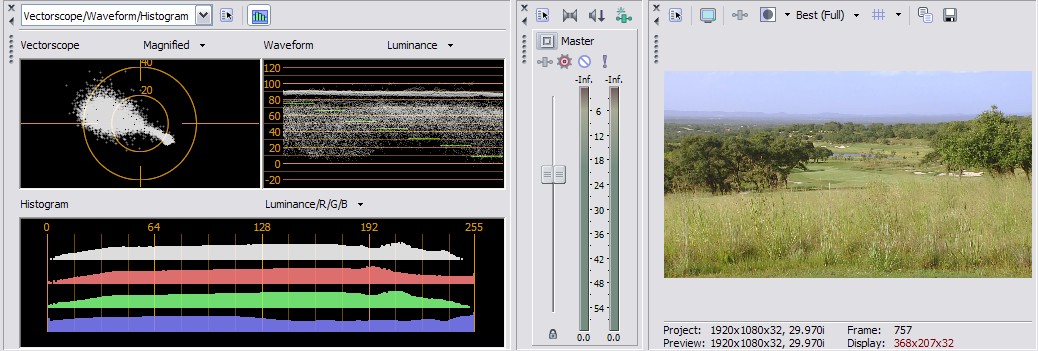
Similar Threads
-
HD mpeg2 transport stream re-quantization?
By live4ever in forum DVB / IPTVReplies: 2Last Post: 21st Jul 2009, 20:25 -
Help Please: Looking for MPEG2-ts (Transport Stream) Recovery Software
By Moon43 in forum ComputerReplies: 13Last Post: 11th May 2009, 16:20 -
MPEG2 transport stream software
By PCNG in forum Newbie / General discussionsReplies: 1Last Post: 7th Jan 2009, 15:10 -
Re-encoding MPEG2 Transport Stream (.ts) file
By kary.sharma in forum Video ConversionReplies: 2Last Post: 12th Dec 2008, 05:01 -
need MPEG2 Transport stream and Program stream profiler
By afarun in forum ProgrammingReplies: 3Last Post: 23rd Aug 2007, 02:06




 Quote
Quote